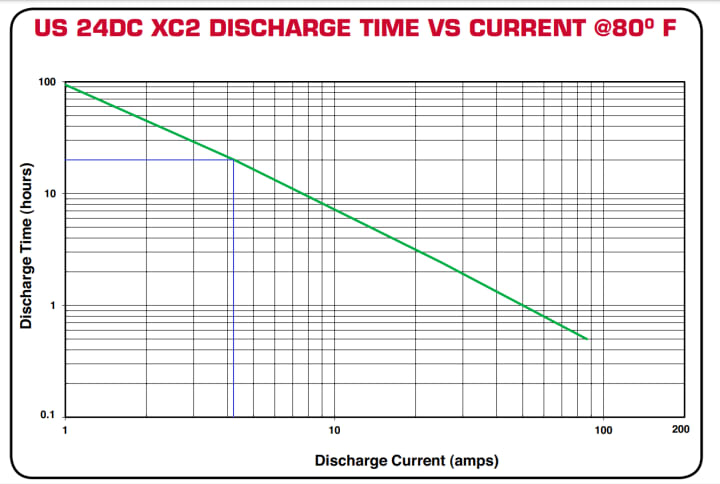
INTRODUCTION
My friend recently was moaning about making minimum profit with his food deliveries due to the rising gas prices. With several old e-bike parts just sitting in my computer room and an unutilized bike blocking the door downstairs, I made an offer to construct him an e-bike.
With a very limited budget and high expectations, he assumed that the e-bike would be quickly completed in a week. So while waiting for parts, he complained to me why I cannot use a common 12V car battery instead; he claimed that they are relatively cheaper and more available.
In layman's terms, I explained to him that only lithium batteries can fit the weight, charging speed, and range requirements; here however we will explore the reasoning of behind that conclusion. In order to compare the batteries types, we must convert all units to watt-hours under the same standards (@20hr rate; 27°C).
EQUIPMENT
- US 24DC XC2 FLA (US Battery Manufacturing Company)
- 48V 30A⋅hr lithium (unidentified)
VARIABLES
VARIABLE (ABBREVIATION; UNIT) : STANDARD [RESTRICTIONS]; [REASONING]
CONTROLLED
INDEPENDENT
INTERMEDIATE
DEPENDANT
RESEARCH
Online I found that two major issues converting the reserve capacity into amp-hours:
- Batteries without manufacturer data sheets
- Websites converting by using the ratio:
RC @ 25A : 25A while V > 10.5V
or something similar to these terms:
q (C) = RC x (60 s/min) x 25A (C/s) while V > 10.5V
Peukert's law describes the reserve capacity as the time required for the battery to reach 10.5V depending on the discharge current; however because Peukert's law is non-linear between the two, a graph from the manufacturer is required to make the calculations.
AMP-HOURS

Solve for the discharge current @ 20hr using the graph
I = 4A + (11px/47px)A
I = 4A + 0.23404255319148936170212765957447A
I ≈ 4.23A
AMP-HOURS: GENERAL EQUATION
A⋅hr = (I @ t hour rating)(t)
Solve for the amp-hours @ 20hr
A⋅hr = (I @ 20hr)(20hr)
A⋅hr = (4.23A)(20hr)
A⋅hr = 84.6 A⋅hr
A⋅hr (expected) = 85 A⋅hr
TOTAL CAPACITY
Because the car batteries have the higher amp-hours, one might assume that car batteries have the advantage in range; however converting the amp-hours to watt-hours will show its total capacity as hinted in its variable name.
TOTAL CAPACITY: GENERAL EQUATION
TC = V x A⋅hr
Solve for the total capacity @ 20hr (US 24DC XC2 FLA)
TC = 12V x 85 A⋅hr
TC = 1020 W⋅hr
Solve for the total capacity @ 20hr (48V 30A⋅hr lithium)
TC = 48V x 30 A⋅hr
TC = 1440 W⋅hr
EFFICIENCY
The lithium batteries have higher energy densities as well improving the size, the shape, and the weight. This helps especially when your batteries are out of juice and you still need make a few more rounds.
BATTERY EFFICIENCY: GENERAL EQUATION
η = total capacity / m
Solve for the total capacity @ 20hr (US 24DC XC2 FLA)
η = 1020 W⋅hr / 23.0 kg
η = 44.347826086956521739130434782609 W⋅hr/kg
η ≈ 44.3 W⋅hr/kg
Solve for the total capacity @ 20hr (48V 30A⋅hr lithium)
η = 1440 W⋅hr / 5.50kg
η = 261.81818181818181818181818181818 W⋅hr/kg
η ≈ 262 W⋅hr/kg
CONCLUSION
While FLA batteries are relatively cheaper and more available, the lithium battery has:
- slightly more range (about 1 .4 times; 1440 W⋅hr/1020 W⋅hr)
- better range for less weight (almost six times; 262 W⋅hr/kg/44.3 W⋅hr/kg)
The lithium battery is best choice for his food delivery scenario. As a final point, I have seen a lot of bikes fall over and car batteries use plastic cases and are full of acid so...
About the Creator
Wilson Ng
Producing stories by mixing my professional and gaming experiences with my education in ECET A&I option at BCIT






Comments
There are no comments for this story
Be the first to respond and start the conversation.